News
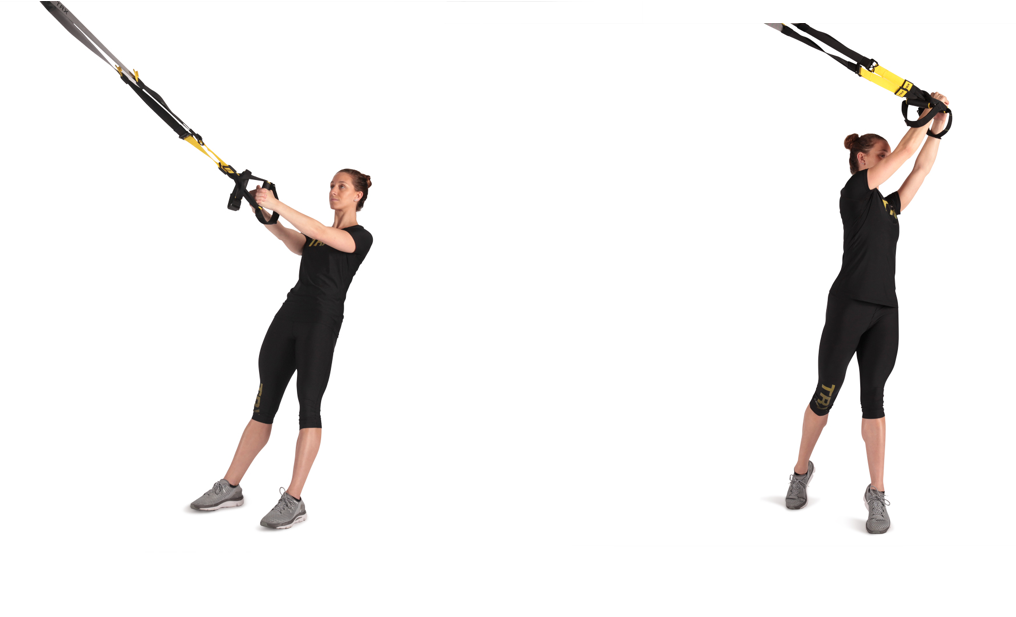
TRX Rotation and Core Workout
Single-arm and single-leg movements performed on the TRX Suspension Trainer increase your instability, requiring greater total-body muscle recruitment. Want to find the right unilateral exercises for your strength level? Take our quick assessment quiz to get a personalized training plan. In this video, DB Strength founder and MMA coach Doug Balzarini shows you five of his favorite single-arm and single-leg TRX exercises.
1. TRX Single Arm, Single Leg RowSet up as if you were performing a TRX Single Arm Row, but lift one leg off of the ground (the leg of the arm you are pulling with). This will force you to fight rotation and stabilize your entire body through your core. Keep shoulders and hips square to the anchor throughout the entire exercise.
2. TRX Single Arm, Single Leg SquatSimilar to the row listed above, this exercise challenges your ability to resist rotation. Having only one base of support--a single foot--increases the difficulty and forces you to brace your core to maintain stable.
3. TRX Single Arm, Single Leg Balance ReachApplying pressure into the handle with one hand will help to engage your lats (upper back muscles) and core throughout the exercise. Maintain a neutral spine throughout, keep your elevated foot pointed down to the floor and keep your hips squared at all times.
4. TRX Single Arm, Single Leg Side PlankPlace one foot in both foot cradles and rest the other leg on top while you get set up. This exercise can be performed from either the forearm or the hand. Place your top hand on your hip, and keep your shoulders, hips and knees in line.
5. TRX Single Arm, Single Leg High Plank HoldPlace one foot in both foot cradles and get into a plank position. Carefully lift your free leg off the ground and lift the opposite arm.
Doug Balzarini has been in the fitness industry for the past 14 years. He is originally from Massachusetts where he earned his undergraduate degree in exercise physiology and had his first personal training job. He moved to San Diego in 2000 and worked for the American Council on Exercise (ACE) for five years before starting his career at Fitness Quest 10 as a personal trainer and strength coach. He was there from 2005 to 2011 and worked with clients of all ages and abilities. Doug is the strength coach for Alliance MMA in Chula Vista, California and creator of DBStrength.com.Purchase your TRX Suspension Trainer here.
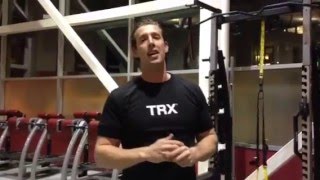
TRX Shoulder Prehab Routine
With March Madness taking center stage in the sports world, we asked the head strength coach for Men’s Basketball at Washington State University, Scott Thom, to explain the importance of preventing injury when the season is on the line. To counter muscular imbalances from the rigors of playing, training and everyday life, Scott uses TRX in his weight room to activate and strengthen muscles often neglected. With stronger muscles, his players are able to correct imbalances, improve their movement patterns, stay injury free and ultimately perform better on the court when it matters most.
My athlete’s world is often dominated by work done in the frontal plane, from playing basketball, to homework on the computer, to a plethora of cell phone texts and social media posts. On a side note, I’ve never seen a selfie taken in the dorsal plane. All joking aside, this can lead to an imbalance in muscular development. It’s not uncommon for my players to show signs of upper cross syndrome, internally rotated shoulders. This muscular imbalance will affect their ability to perform certain exercises and can lead to poor movement patterns and injuries.
As a strength coach, one of my top priorities is keeping my players injury free throughout the season. Basketball is a game where a lot of work takes place overhead from shooting, rebounding, blocking shots and cutting off passing lanes. Want to find the perfect prehab routine for basketball players? Take our quick assessment quiz to get a personalized shoulder stability program. I can help correct these imbalances by incorporating a shoulder prehab routine using the TRX during their pre-lift warm-up. I often call these routines, activation circuits, helping my players understand we are trying to "activate" the areas often ignored in their day to day lives; rhomboids, traps, rear deltoids to name a few. When strengthened, these areas can help correct upper cross syndrome, allowing the athlete to move more efficiently.
TAKE OUR TRAINING QUIZ
The Exercises
1. Press-Ups x10 (TRX Wall Slides)
*Athlete is in an upright position, slightly leaning back to create tension on the TRX, legs are straight, toes point to their nose, athlete presses upward in a military press style.
2. Scapular Rows x10 (TRX Scapular “Js”)
*Athlete positions in an inverted row, arms are straight, scaps protract and retract.
3. Alligators x10 (TRX Split Flys)
*Athlete slightly leans back, arms are straight, using their upper back and rear deltoids they pull the TRX apart by the handles, which moves their body forward, concentric and eccentric portion of the exercise is done at the same tempo.
4. Inverted Row x10 (TRX Low Row)
*Athlete leans back, body stays straight and strong, heels in the ground, toes up, hips and shoulders are in alignment, athlete pulls handles to their sides, while keeping shoulder back.
We will go through this circuit one time before every upper body lift. So, whether you’re a D1 athlete or a weekend warrior, this TRX shoulder prehab routine when done consistently will help strengthen muscular imbalances in your body and prevent injury.
Coach Thom- Create a great day!
Bio:
Scott Thom is wrapping up his second season with the Washington State University men’s basketball program as the team’s strength and conditioning coach/player development, after serving in the same capacity at California the previous four years. Prior to joining the staff at California, Scott coached basketball and taught physical education for seven years at Vintage High School in Napa, Calif. Scott received his bachelor’s degree in physical education from Chico State in 2002, a teaching credential in physical education from Sonoma State, and a masters in Coaching and Athletic Administration from Concordia University. He is certified though both CSCS and USAW. Scott writes articles for STACK and HarbingerFitness.
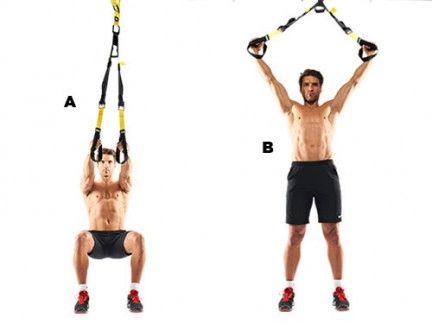
TRX Shoulder and Back Workout
TRX Training
This video, submitted by educator Nick Tumminello, shows what he calls his 15/30 Workout, guaranteed to exercise the entire upper back and pulling musculature using two TRX staples: the TRX Y Deltoid Fly and the TRX Low Row.
Click here to watch video.
Start with the TRX Y Deltoid Fly to ensure optimal muscular recruitment of the often weak and down-regulated scapular stabilizer muscles (such as the lower traps) throughout the workout. Want to find the right progression for your shoulder strength and stability? Take our quick assessment quiz for a personalized training plan. Also, because the TRX Y Deltoid Fly involves the smaller, weaker muscles, it should be performed first while you are fresh and less likely to compensate due to fatigue.
TAKE OUR TRAINING QUIZ
Coaching Tips:
Maintain body alignment throughout the entire 15/30 workout.
Do not lead with your hips or extend your lower back.
Do not use momentum to lift your body. Keep the movement controlled.
Lift your toes off the ground through the workout to ensure your legs are not taking some of the load.
Keep tension on the TRX while at the top of each exercise. Never allow slack in the TRX straps.
When performing the TRX Y Deltoid Fly, keep shoulders neutral with your thumbs pointing behind you. This minimizes any potential shoulder impingement irritation.
When performing the TRX Low Row, keep your wrists straight and pull far enough to bring your wrists parallel to your ribs.
Try to maintain a proper mind-muscle connection so you can exercise every muscle group, such as the lats.
Progressions and Regressions:
You can quickly adjust the difficulty of both the TRX Y Deltoid Fly and TRX Low Row by moving your feet closer or further away from the anchor point.
For weaker individuals, the rep scheme can be adjusted to 5/10, 10/20.
Always try to progress to the full 15/30 workout protocol.
Perform one to three sets per workout with one to two minute rest in between.
Do your next workout with our TRX equipment:
TRX® PRO4 SYSTEM
BUY NOW
TRX® HOME2 SYSTEM
BUY NOW
TRX® TACTICAL GYM
BUY NOW
Nick Tumminello is the founder of Performance University and inventor of the Core Bar™. He is an international speaker and educator and serves as the performance expert for the Esquerre Fitness Group, where he consults with health clubs throughout the nation. He is a regular contributor to numerous magazines such as Men’s Health and Men’s Fitness along with multiple websites including T-Nation.com, PTontheNET.com, StrengthCoach.com and SportsRehabExpert.com.

TRX Rip Training: Stability Principle
Watch TRX Director of Rip Training, Pete Holman, show you how to develop strength in your core, lower back, lats, shoulders, arms and legs by incorporating the Stability Principle into your Rip Training regimen.
You may remember the Stability Principle from the TRX Principles of Progression. Essentially, the more points of contact your body has with the ground and the wider your base of support, the easier an exercise will be. Think of it in terms of architecture. A building with a wide base and a low center of gravity, like a pyramid, is going to be far more stable and harder to topple than a building with a narrow base and a high center of gravity, like a sky scraper.
If you want to increase the difficulty of any Rip exercise, try turning your pyramid into a skyscraper by narrowing your base of support (bringing you feet closer together), which will force you to stand up taller, moving your center of gravity higher. If your base is less stable, it forces you to recruit more stability from your core. As you can see in the video above, when Jamie brings his feet together to perform a Rip Press, he really needs to engage his core and lower back to achieve the necessary proximal stability for distal mobility.
Purchase your Rip Trainer here!
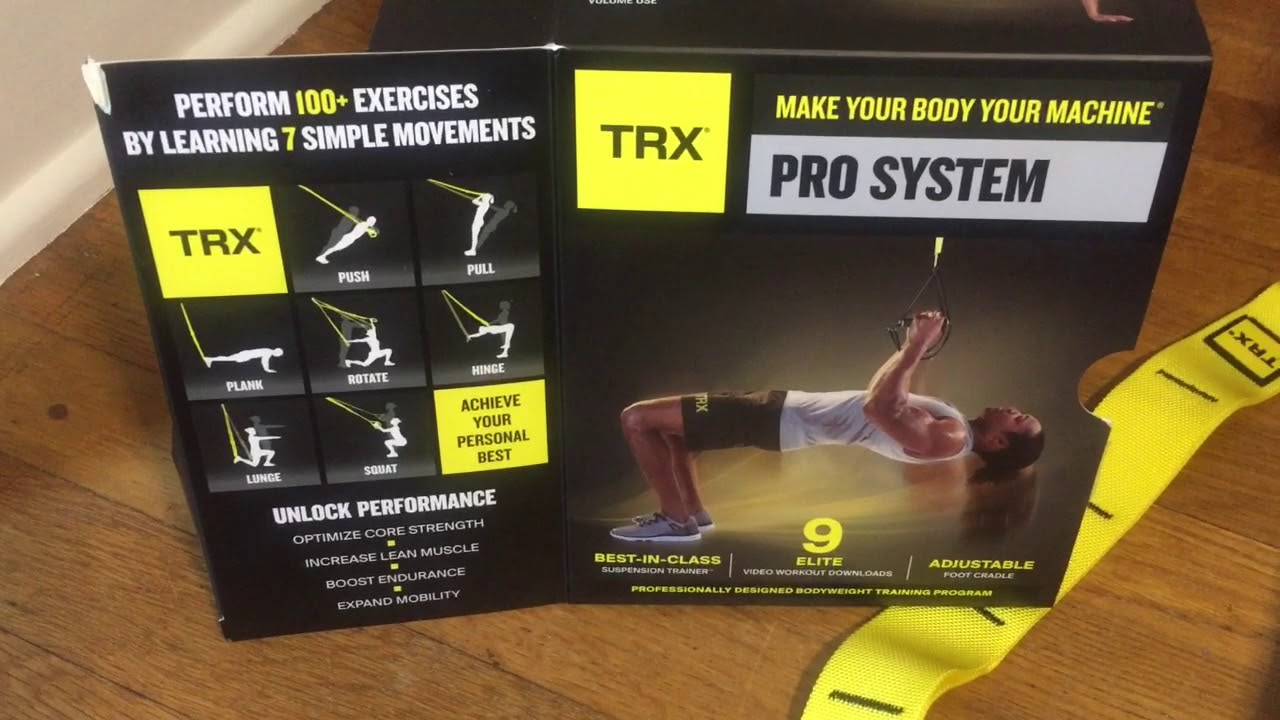
TRX Rip Trainer: The Unboxing
While we try to put out a solid stream of useful content about Rip Training exercises, we also get a fair number of questions from the curious ones that fall into the "how-to" category. How do you anchor it? What comes in the kit? How diverse are the exercises? What kind of programming do you get?
TRX Director of Rip Training Pete Holman just put together this quick video to cover some of those questions for you.
Created by a two-time US National Taekwon do champion, the TRX Rip Trainer uses the asymmetrical loading of the resistance cord to constantly challenge one’s balance and force maximal muscle recruitment. Like the Suspension Trainer, the Rip Trainer is lightweight (~4lbs), portable, easy to setup and versatile, and it allows anyone at any level to get a full body workout. However, while the TRX Suspension Trainer is a static stability and strength device, the TRX Rip Trainer is a dynamic explosive power and metabolic device emphasizing rotational movements.
Stop by our store to see what other pro trainers are saying about TRX Rip Training and to learn more about the TRX Rip Trainer Kit. Please let us know if you have any specific questions so that we can address them.

TRX Rip Fusion Workout
Here’s an awesome TRX Suspension Trainer and Rip Trainer fusion workout from the beautiful island of Maui, with TRX Group Programming and Development Manager Dan McDonogh and TRX Master Trainer Alexandre Veret from France. These four exercises are ideal for activating your abs, lower back, shoulders and legs, or as McDonogh points out the anterior and posterior core, to develop 360-degree strength and stability.
Something to note, when we use the term “anterior core,” we are referring to the abdominal muscles that make up the front side of the body. When we use the term “posterior core,” we are referring to the glutes, lower back and middle back. Because the majority of these exercises have some sort of asymmetrical loading, they force you to engage your obliques and lats as well as your anterior and posterior core in order to resist going into rotation. The takeaway: this sequence has a huge return on investment for a total body workout.
The Sequence:
TRX Single Arm Hip Hinge
Rip Squat with I Deltoid Raise
Rip Reverse Lunge with a Pullover
TRX Overhead Back Extension
Perform each of these four exercises for five to seven reps per side (that means you are going to do eight sets total). Finish both sides of each exercise before moving on to the next.
Want more? Check out Part 2 of this series here.
Get your TRX Suspension Trainer here and your TRX Rip Trainer here.

TRX Recovery Workout
FROM THE VAULT: Statistics say you'll catch two to four colds per winter, regardless of rigorous application of hand sanitizer and avoidance of sick coworkers. We know your workouts are important to you, but during a cold, can exercise actually further compromise an already stressed immune system—or help it?
A 2001 study conducted by Albert Moraska and Monika Fleshner and published in the The American Journal of Physiology found that the intensity of exercise can either enhance or suppress immune function. Considerable research shows that during moderate exercise, several positive changes occur in the immune system, whereas strenuous or lengthy exercise sessions are followed by an impairment of the immune system.
Your best bet is to do a “neck check.” If your symptoms are located above the neck (e.g. stuffy nose and a sore throat), exercise at a moderate intensity is likely safe and possibly even beneficial. However, if there are “below-the-neck” symptoms such as a vomiting or diarrhea and if you have a fever, allow yourself to rest.
One of the many fantastic benefits of the TRX is its ability to adapt to any level of strenuousness. So if you feel a cold coming on, or if everybody in your house is coughing, give this easily regressable TRX workout a try, which may save you the misery of three weeks of a cold. Not sure about your ideal exercise intensity? Take our quick fitness quiz to get customized workout recommendations that match your current energy levels and goals. Perform 45 seconds of each exercise. (NOTE: The video is a bit longer than usual, but we felt it was important to address each of the foundational movements and offer tips on how to regress them. Times have been provided for ease of viewing.)
TAKE OUR TRAINING QUIZ
1. TRX Assisted Squat (1:12)
Regression: Use the TRX more for assistance throughout the full range of motion.
2.TRX Chest Press (1:47)Regression: Walk your feet forward to decrease your angle.
3.TRX Single Arm Row (2:30)Regression: Walk your feet back to decrease your angle.
4. TRX Assisted Side Lunge (3:14)Regression: Start with your feet apart and use the TRX for assistance throughout the full range of motion.
5. TRX I/T Shoulder Combo (3:56)Regression: Take a longer offset foot stance and move both feet back to decrease your angle.
6. TRX Torso Rotation (4:44)Regression: Walk your feet back to decrease your angle and rotate arms up at a higher angle.
7. TRX Hamstring Curl (5:29)Regression: Slide forward so your feet are in front of the anchor point and gravity will assist you through the full range of motion.
8. TRX Assisted Knee Raises (6:30)Regression: A greater knee bend will reduce the force through the range of motion.
These exercise regressions can be used for not just those feeling under the weather but many individuals from TRX newbies to the deconditioned to seniors... anyone who needs to scale back the intensity but not sacrifice results.
Shana Martin (www.shanamartin.com) is a TRX Senior Instructor, fitness expert, world champion lumberjack athlete, national spokesperson, fitness competitor, gymnast, pole vaulter, runner... the list goes on! Shana graduated from the University of Wisconsin with a degree in Kinesiology – Exercise Science. She is the current fitness director at Supreme Health and Fitness in Madison, and also does personal training and teaches group exercise. Shana was introduced to the TRX Suspension Trainer at the Club Industry Fitness Convention in Chicago after winning the TRX Atomic Push-up Challenge. Since then she has been using the TRX every day with every client. She also credits her sports success and fast rehabilitation after reconstructive knee surgery to the TRX.
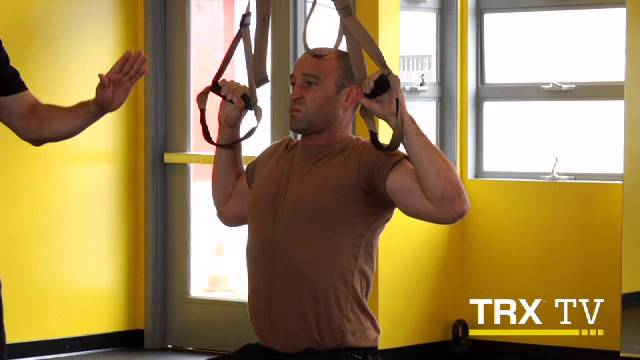
TRX
TRX Pull Up
TRX Training
Watch this video to learn how to perform a TRX Pull Up. And for a truly customized training plan that matches your current strength level, take our quick fitness assessment quiz - it'll help you build the perfect workout progression. Pair this with our other TRX exercises for a well-rounded workout.
TAKE OUR TRAINING QUIZ
Here's the gear you can use to do a TRX Pull Up today (plus more with the Ybell and Strength Bands):
TRX® PRO4 SYSTEM
BUY NOW
TRX® HOME2 SYSTEM
BUY NOW
TRX® TACTICAL GYM
BUY NOW
You can also combine the TRX pull-up with other TRX exercises for a more effective full-body workout. For inspiration, try one of our classes at TRX Training Club:
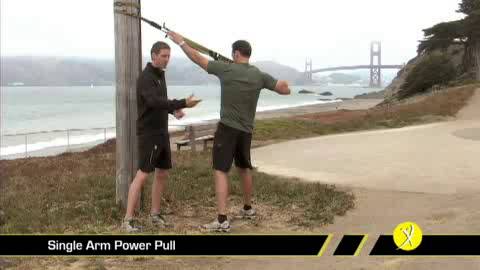
TRX Power Pull
The TRX Power Pull presents unilateral back strength demands coupled with rotational strength and control, shown here with Fraser Quelch and TRX founder and CEO Randy Hetrick.
TAKE OUR TRAINING QUIZ
